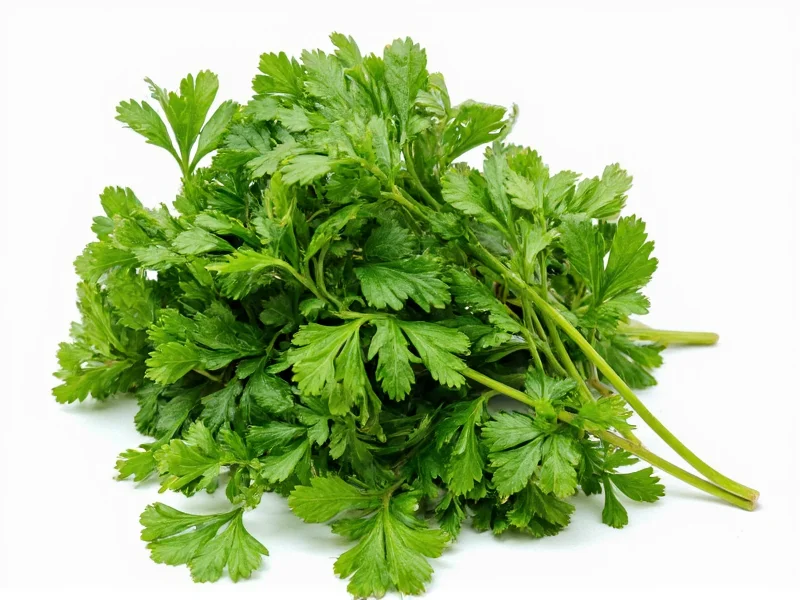Understanding herb conversions is essential for successful cooking. When a recipe calls for fresh parsley but you only have dried (or vice versa), knowing the proper substitution ratio prevents flavor imbalances in your dishes. The 1:3 ratio between dried and fresh parsley exists because the drying process concentrates the herb's essential oils while removing water content.
Why Dried and Fresh Parsley Require Conversion
Fresh parsley contains approximately 85-90% water, which evaporates during the drying process. This concentration means dried parsley delivers more intense flavor in a smaller volume. Using equal measurements would result in either a bland dish (using too little dried parsley) or an overpowering herbal taste (using too much).
Detailed Parsley Conversion Chart
| Dried Parsley | Fresh Parsley Equivalent | Common Recipe Application |
|---|---|---|
| ¼ teaspoon | ¾ teaspoon chopped | Salad dressings, light sauces |
| ½ teaspoon | 1½ teaspoons chopped | Marinades, egg dishes |
| 1 teaspoon | 1 tablespoon chopped | Most standard recipe measurements |
| 1 tablespoon | 3 tablespoons (¼ cup) chopped | Stews, soups, hearty dishes |
| 2 tablespoons | 6 tablespoons (¼ cup) chopped | Large batch cooking |
Practical Conversion Examples in Cooking
Consider these real kitchen scenarios where proper dried to fresh parsley conversion matters:
Tomato Basil Pasta Sauce
If your recipe calls for 1 teaspoon dried parsley but you prefer fresh, use 1 tablespoon chopped fresh parsley added near the end of cooking. Adding fresh herbs too early diminishes their bright flavor.
Chicken Brine Solution
For a brine requiring 2 tablespoons dried parsley, substitute with 6 tablespoons (¼ cup) fresh parsley. Since brines steep for hours, fresh parsley holds up well in this application.
Salad Garnish
Never substitute dried parsley for fresh as a garnish. The texture and appearance differ significantly. Dried parsley works best in cooked dishes where appearance matters less.
Factors Affecting Parsley Conversion Accuracy
Several variables influence how precisely your conversion will work:
- Herb quality: Freshness of both dried and fresh parsley affects potency
- Storage conditions: Properly stored dried herbs maintain potency for 1-2 years
- Cooking method: Long simmering reduces fresh herb intensity
- Parsley variety: Curly vs. flat-leaf (Italian) parsley have slightly different flavor profiles
Common Conversion Mistakes to Avoid
Cooks frequently make these errors when substituting parsley forms:
- Using equal measurements without conversion
- Adding fresh parsley too early in cooking, causing flavor loss
- Using dried parsley as a garnish (results in unpleasant texture)
- Not adjusting for recipe moisture content (drier recipes may need slightly more fresh parsley)
When to Choose Dried Over Fresh Parsley
Dried parsley works better than fresh in specific situations:
- Long-cooking dishes like stews and soups (up to 2 hours simmering)
- Dry rubs for meats where moisture would prevent proper browning
- Situations requiring extended shelf stability
- When fresh parsley isn't available
Conversely, fresh parsley shines in:
- Finishing dishes (garnishes, last-minute additions)
- Cold preparations like salads and dressings
- Dishes where bright, grassy notes are desired
- Recipes with short cooking times
Storage Tips for Maximum Flavor Preservation
Proper storage maintains conversion accuracy by preserving herb potency:
Fresh parsley: Store stems in water (like flowers) in the refrigerator, covered with a plastic bag. Use within 1-2 weeks for optimal flavor. Freezing chopped parsley in oil preserves it for cooking applications.
Dried parsley: Keep in airtight containers away from light and heat. Properly stored, it maintains good flavor for 1-2 years. After this, potency decreases, requiring slightly more for equivalent flavor.
Testing Your Conversion Success
The best way to verify your dried to fresh parsley conversion worked is through careful tasting. When substituting:
- Add the converted amount to your dish
- Cook as directed
- Taste before serving
- Adjust with small additional amounts if needed
Remember that individual taste preferences vary, so these ratios serve as reliable starting points rather than absolute rules.
Expanding Your Herb Conversion Knowledge
While parsley follows the standard 1:3 dried to fresh ratio, other herbs have different conversion requirements. Most leafy herbs like basil, oregano, and thyme follow the same ratio. However, more potent herbs like rosemary and sage use a 1:4 ratio (1 teaspoon dried equals 4 teaspoons fresh) due to their concentrated oils.











 浙公网安备
33010002000092号
浙公网安备
33010002000092号 浙B2-20120091-4
浙B2-20120091-4